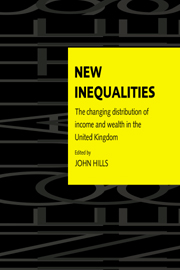Book contents
- Frontmatter
- Contents
- List of figures
- List of tables
- List of contributors
- Acknowledgements
- 1 Introduction: after the turning point
- Part I Income distribution
- 2 Seeking to explain the distribution of income
- 3 The changing shape of the UK income distribution: kernel density estimates
- 4 UK household cost-of-living indices, 1979–92
- 5 Cost-of-living differences between the regions of the United Kingdom
- Part II Components of income
- Part III Spatial aspects
- Part IV Income and wealth
- Bibliography
- Index
2 - Seeking to explain the distribution of income
from Part I - Income distribution
Published online by Cambridge University Press: 22 September 2009
- Frontmatter
- Contents
- List of figures
- List of tables
- List of contributors
- Acknowledgements
- 1 Introduction: after the turning point
- Part I Income distribution
- 2 Seeking to explain the distribution of income
- 3 The changing shape of the UK income distribution: kernel density estimates
- 4 UK household cost-of-living indices, 1979–92
- 5 Cost-of-living differences between the regions of the United Kingdom
- Part II Components of income
- Part III Spatial aspects
- Part IV Income and wealth
- Bibliography
- Index
Summary
Economists sometimes vaguely wonder why economic theory is so unpopular … Is there anything in this to excite surprise, if we reflect for a moment on the inadequacy of the answer furnished by the theory of distribution, as at present taught, to the questions in which the ordinary person is interested?
(Cannan, 1905)Introduction
There is little doubt that the distribution of income in the United Kingdom has become more unequal since 1979. Average real incomes have grown significantly, but at the bottom of the scale there has been little or no rise in real income, whereas top incomes have risen a great deal faster than the average. This widening of income differences is a departure from the pattern of previous decades in the United Kingdom which saw a modest reduction in income inequality over the post-war period. Similarly, inequality has increased in the United States. According to the 1994 Economic Report of the President, ‘starting some time in the late 1970s, income inequalities widened alarmingly in America’ (Council of Economic Advisers, 1994: 25).
What can explain this rise in inequality? Why has the previous trend been reversed? What is the likely future development? The lay person may well expect to find these questions addressed and answered in economic textbooks. The distribution of income is surely central to the understanding of the working of the economy. Yet, as Cannan indicated 90 years ago, the ordinary person will be disappointed.
- Type
- Chapter
- Information
- New InequalitiesThe Changing Distribution of Income and Wealth in the United Kingdom, pp. 19 - 48Publisher: Cambridge University PressPrint publication year: 1996
- 23
- Cited by



